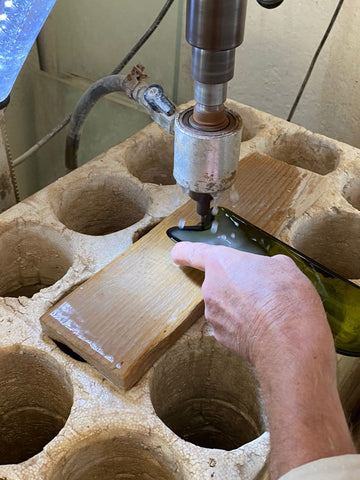Glass is one of the most sustainable materials around thanks to its durability and ability to be recycled practically endlessly . Its versatility allows it to be used in different sectors, from food and drink packaging to the production of art objects. In short, it represents a point of reference in the promotion of eco-sustainable practices.
However, despite its remarkable recyclability properties , discussions about the actual sustainability of glass tend to focus not only on recycling, but also on reuse. This article intends to explore in depth the comparison between the environmental impact resulting from the reuse of glass compared to that linked to its recycling. Let's find out more in the next lines.

Glass, a material for sustainability
Glass is a material used by humans for millennia. Over time it has evolved, moving from a luxurious ornament to a material for everyday use , fundamental for the conservation and transport of goods. Its ability to pass through time without losing its properties and qualities makes it a perfect material from an environmental sustainability perspective.
Glass is infinitely recyclable and keeps its properties unchanged, allowing a significant reduction in natural resources and CO2 emissions linked to the production of new material. Glass recycling, a process that crushes, melts and reforms the material, is an excellent example of a circular economy, helping to reduce waste sent to landfill and the energy needed for production.
Reusing glass is also an effective waste management strategy that promotes the prolonged use of objects before they enter the waste cycle. This practice, which extends from the simple reusability of containers and bottles to more creative initiatives such as those carried out by Amarzo, highlights the importance of reducing, reusing and recycling in the context of responsible consumption.

The glass recycling process
The glass recycling process begins with collection, which can take place through specific containers for separate waste collection or dedicated collection points. Subsequently, the collected glass is transported to the treatment plants, where the separation phase takes place: here, the glass is divided by color and removed from any impurities or non-recyclable materials, such as caps or labels, to guarantee the high quality of the material recycled.
The next phase is fusion, during which the glass, once cleaned and ground into small fragments called calcin, is heated at high temperatures until it becomes a homogeneous liquid . This allows it to be reshaped, in the forming phase, into new objects, without any loss of purity or quality, regardless of the number of recycling cycles.
The advantages of glass recycling are numerous, especially from an environmental point of view: it reduces the extraction of raw materials, reduces energy consumption and CO2 emissions associated with the production of new glass, and limits the amount of waste sent to landfill.
However, there are also limitations, such as the need for accurate color separation to avoid contamination that can compromise the quality of the recycled glass and the challenge posed by collection and transport logistics, which must be efficient to make the process sustainable and cost-effective .

Reusing glass: benefits and practices
The reuse of glass is a fundamental sustainable practice that precedes and completes recycling. While recycling involves the transformation of glass into a new product through melting processes, reuse focuses on the use of the same object for the same purposes and functions, without the need to use treatments that use energy.
The practical applications of glass reuse are almost endless. Some good ideas translate into recycled glass coffee cups , designer glass lamps and glass cocktail glasses . In addition to these examples, there are also many other ideas that can represent perfect eco-sustainable gift ideas for special occasions .
The environmental benefits of reusing glass over recycling are significant. First of all, reuse drastically reduces energy consumption, as it avoids the high-temperature melting processes necessary for recycling, thus also minimizing greenhouse gas emissions. Furthermore, it contributes to reducing waste, extending the useful life of glass objects and reducing the frequency with which they need to be replaced. This not only limits the amount of waste sent to landfill but also slows the demand for new raw materials, conserving precious natural resources.
Conclusion
Glass is one of the most effective materials when it comes to sustainability. Thanks to its ability to be reused countless times, glass is the point of reference for people looking for environmentally friendly objects. Amarzo makes glass its main focus and uses this material to produce the products available in store.
Discover the Amarzo shop and the products made from reused glass


